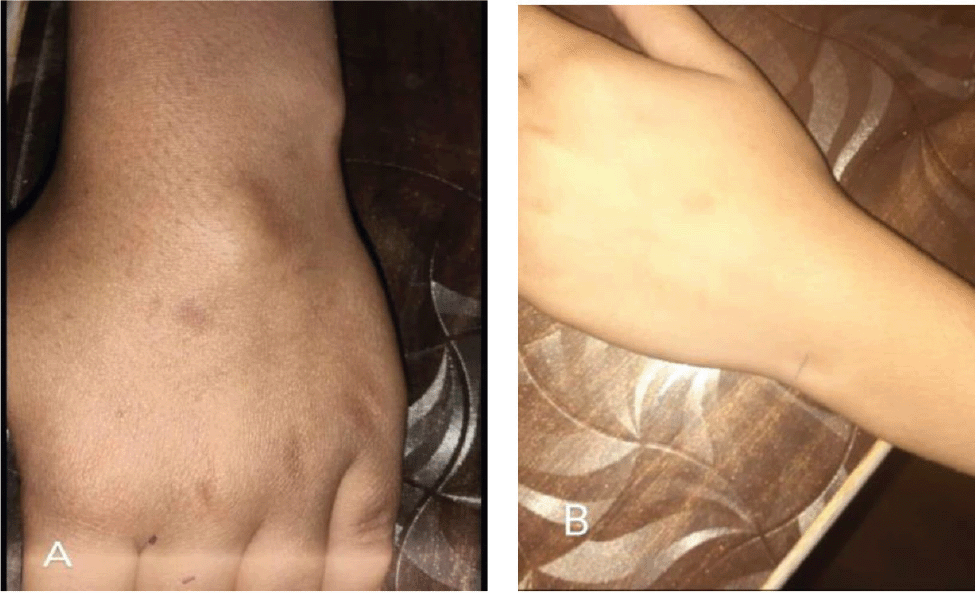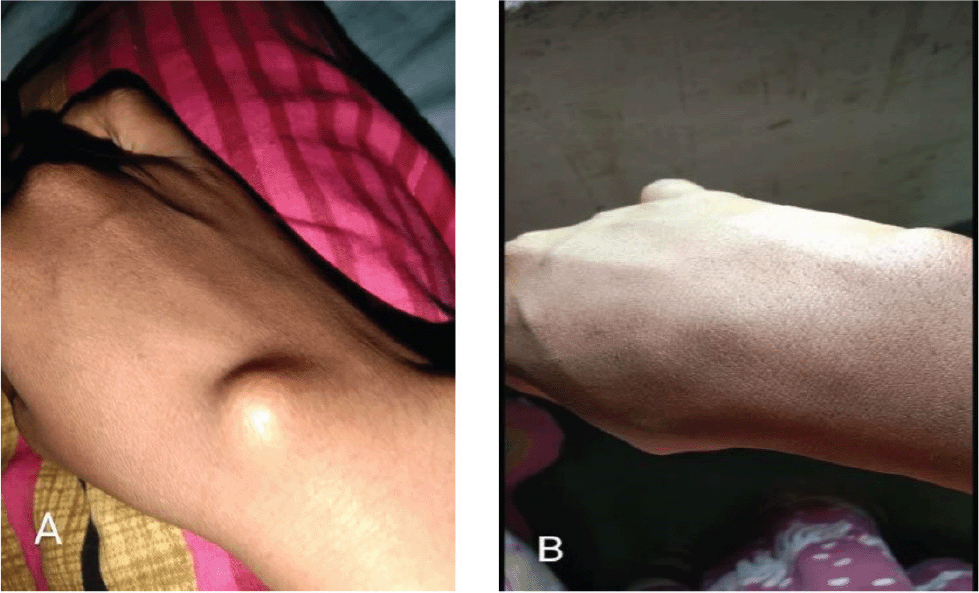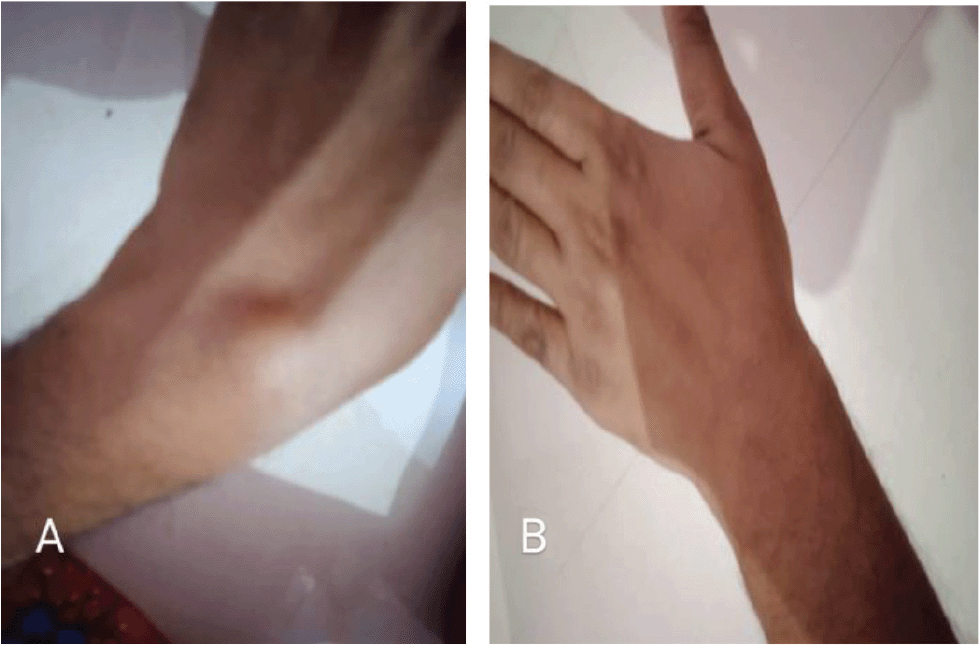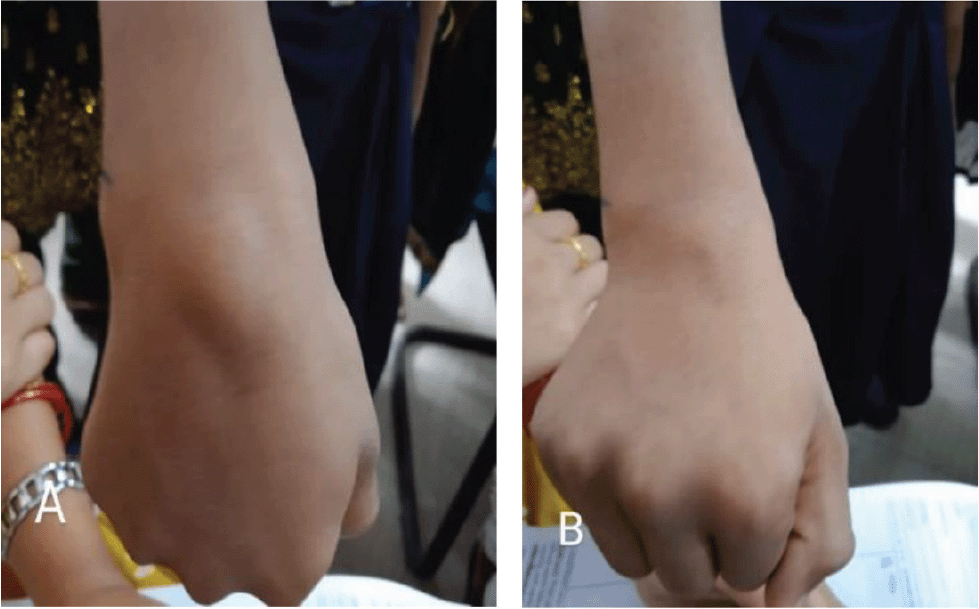
Integrative Medicine Case Reports, Volume 4, Issue 2 (July), 2023
Efficacy of individualized homoeopathic medicine in wrist ganglion: an evidence based case series
KEY WORDS |
ABSTRACT |
|
Wrist ganglion
|
Ganglions are a small cystic tumor containing viscid fluid and are non-malignant growths that usually forms near the joints and tendons of the hand and wrist. They are harmless and non-cancerous growth, mostly asymptomatic. Pain, tenderness, annoyance with cosmetic appearance associated with some cases. Though homoeopathic literature enlists many medicines for wrist ganglion, there is paucity of evidence based published studies. The patients presented with the complaints of firm to hard swelling at the dorsum of hand. After meticulous case taking, analysis and evaluation of the symptoms followed by Repertorization of the characteristics, the similimum was selected. A single, simple medicine with minimum dose was administered in each case followed by placebo. Four cases were treated with Phosphorus 200, Calcarea carbonica 1M, Phosphorus 1M and Sulphur 200 respectively. Single dose of medicines was administered as per cardinal principles of homoeopathy and waited for 3 months. Striking improvement in symptomatology was noted after the course of treatment. Homoeopathic medicines selected on the basis of strict individualization showed promising result in all four cases. Patients reported reduction of symptoms as well as general wellbeing following the treatment. Further studies with sound methodology are suggested to evaluate the efficacy of larger spectrum of homoeopathic medicines in the treatment of wrist ganglion. doi: 10.38205/imcr.040246 |
|
*Corresponding Author:
|
Introduction
The myxomatous degeneration of the synovial sheath lining the joint or tendon causes ganglions, which are tight, cystic swellings. Because of the abundance of fibrous tissue, they are commonly found around joints. They contain gelatinous fluid (1). The wrist is the commonest site (2). Male prevalence is 25/100,000, whereas female prevalence is 43/100,000. Patients reporting wrist pain had a prevalence of 19%, while people without symptoms had a prevalence of 51% (3). Treatment is not essential, as many resolve or cause little trouble; otherwise, surgical excision is the best option (1). The “herniation hypothesis” states that ganglion cysts most frequently form as “an out-pouching or distention of a weakened portion of a joint capsule or tendon sheath (4). The clinical appearance is often sufficient for diagnosis, with the exception of “occult wrist ganglion,” which necessitates MRI and ultrasound. There may be pain in wrist and it may radiate up the patient’s arm. There may also be a reduction in grip strength and range of motion. The position in which the dorsal wrist ganglion is most readily palpable is volar flexion. The volar ganglia may compress the ulnar or median nerves, or their branches, causing paresthesia (5). Homoeopathy is a holistic science, where all the symptoms at the physical, psychological, social and the environmental levels are taken into consideration, is recommended for the treatment of wrist ganglion with correctly chosen remedy and thus provides a better treatment modality for patients suffering from it. As an independent system of medicine, Homoeopathy has ample scope in the treatment of Ganglion but there is lack of sufficient evidences. After extensive searches into different electronic (PubMed, CORE Hom, Embase, etc.) and bibliographic databases, very few numbers of studies were identified evaluating homoeopathy in wrist ganglion (6,7).
Process of study
In each of four cases homoeopathic medicines were prescribed on the basis of individualization through miasmatic approach [The approach comprises peculiar constitutional tendencies or inherited influences to develop certain form of chronic diseases] (12), totality of symptoms and repertorization. Medicines were prescribed in a single dose for a minimum period of three months during which simple unmedicated globules were prescribed. The cases were reported after they were cured.
Case Presentation
Case no 1
Patient information: A 20 years old boy came to O.P.D. with soft cystic swelling around dorsum aspect of left wrist joint for 1 year. He had no significant past and family history. The patient had desire for salty food, aversion to sweets, with profuse and offensive sweat, thermally chilly, tongue was dry, coated. Mentally, the patient desired company and had fear of dogs and was dread of thunderstorm. The Misamatical analysis of this case is shown in (Table 1).
Clinical examination: Round, firm to hard swelling over dorsum of wrist suggestive of wrist Ganglion.
Repertorization: The Repertorization [The technique of finding suitable homoeopathic remedy on the basis of characteristic symptoms of the case] (13) was done [Figure 1] using Hompath software (Complete Repertory). Phosphorus covers maximum rubrics with highest scoring medicine (9).

Figure 1: Case 1: Repertorization chart.
Table 1: Case 1, Analysis & evaluation of symptom with Miasmatical analysis
| S. No. | Symptom | Analysis | Miasmatical Analysis |
|---|---|---|---|
| 1. | Fear of dog | Mental general | Psoro-syphilitic |
| 2. | Desire for company | Mental general | Psora |
| 3. | Fear of thunderstorm | Mental general | Psoro-sycotic |
| 4. | Sweet aversion | Physical general | Psoro-syphilitic |
| 5. | salt or salty food desire | Physical general | Psoro-syphilitic |
| 6. | Profuse perspiration | Physical general | Sycosis |
| 7. | Perspiration offensive | Physical general | Syphilis |
| 8. | Dryness tongue | Particular | Psora |
| 9. | Coated tongue | Particular | Psoro-syphilitic |
| 10. | Ganglion wrist | Particular | Sycosis |
Prescription: After Case taking, Repertorization & differentiation through Materia Medica first prescription was Phosphorus 200/1 Dose/OD.
Table 2: Follow up, Case 1
| Date of visit | Change in Symptoms | Prescribed Medicine/Potency/Dose |
|---|---|---|
| 7 July 2021 | Size of swelling reduced by 50%. No new complain. | Placebo/BDS/1 Month |
| 8 August 2021 | No swelling was seen. Patient was overall better. | Placebo/BDS/1 Month |
| 9 Sept 2021 | No swelling was seen. No new complaint reported. [Figure 2] | Placebo/BDS/1 Month |
Selection of remedy with Justification: Repertorial analysis suggested Phosphorus to be the best suited for this case, which included the general, physical, and mental picture as well as thermal reaction. Selection of potency was based on susceptibility of the patient (11). The follow-up of this case is presented in (Table 2).
Case no 2
Patient information: A 25-year-old man with a dark complexion complaints of a 5-month-old soft cystic swelling on the dorsum of his right wrist joint. Past history revealed that he suffered from malarial fever before 1 year. No notable family history was described by the patient. The patient had strong desire of sweet and meat, aversion to milk, stool was irregular on alternate days, tongue was dry and coated, thermally chilly. Patient was irritable by nature. The Misamatical analysis of this case is shown in (Table 3).
Provisional Diagnosis: Ganglion was diagnosed on the basis of clinical examination.
Table 3: Case 2, Analysis & evaluation of symptom with miasmatical analysis
| S. No. | Symptom | Analysis | Miasmatical Analysis |
|---|---|---|---|
| 1. | Irritability | Mental general | Syco-psoric |
| 2. | Sweet desire | Physical general | Psora |
| 3. | Meat desire | Physical general | Psoro-syphilitic |
| 4. | Milk & milk products aversion | Physical general | Sycosis |
| 5. | Lack vital heat of | Physical general | Psora |
| 6. | Stool, irregular | Particular | Psora |
| 7. | Mouth, coated tongue | Particular | Psoro-syphilitic |
| 8. | Mouth, dryness tongue | Particular | Psora |
| 9. | Ganglion, wrist | Particular | Sycosis |

Figure 2: Case 1: Pretreatment (A), Post-treatment (B).
Repertorization: The Repertorization was done [Figure 3] using Hompath software (Complete Repertory). Calcarea carb covers maximum rubrics with highest scoring medicine (9).

Figure 3: Case 2: Repertorization chart.
Prescription: Calcarea carb 1 M/1 Dose/OD prescribed on date 05/11/2021.
Selection of remedy with Justification: In repertorial analysis Calcarea carb covered all rubrics and & higher scored highest. Then after consulting Materia medica, Calcarea carb was found to be most appropriate for this case covering general, physical & mental picture & also thermal reaction.
Selection of potency was based on susceptibility of the patient (11). The follow-up of this case is presented in (Table 4).
Table 4: Follow up, case 2
| Date of visit | Change in Symptoms | Prescribed Medicine/Potency/Dose |
|---|---|---|
| 10 Dec 2021 | Swelling reduced to 80%. Stool became regular. Overall patient was better. | Placebo/BDS/1 Month |
| 18 Jan 2022 | No swelling was seen. | Placebo/BDS/1 Month |
| 21 Feb 2022 | Patient better. No swelling was seen. No new complaint. [Figure 4] | Placebo/BDS/1 Month |
Case no 3
Patient information: A 22 years boy came to O.P.D. with soft cystic swelling on the dorsal aspect of left wrist (3 mm in diameter) since last 5 months. There was mild pain which aggravated on motion. There was history of trauma on right wrist joint before 5 months. The patient had desire for spicy food, aversion to milk sweat was offensive, tongue was clean and moist. Thermally he is hot. The patient desired company. The Misamatical analysis of this case is shown in (Table 5).
Provisional Diagnosis: Ganglion.
Justification of diagnosis: on the basis of clinical examination.
Table 5: Case 3, Analysis & evaluation of symptom with miasmatical analysis
| S. No. | Symptom | Analysis | Miasmatical Analysis |
|---|---|---|---|
| 1. | Company desire for | Mental general | Psora |
| 2. | Milk & milk products aversion | Mental general | psoro-sycotic |
| 3. | Desire spicy | Mental general | Psora |
| 4. | Perspiration offensive | Physical general | Sycosis |
| 5. | Clean, clear tongue | Particular | Psora |
| 6. | Moist tongue | Particular | Syphilis |
| 7. | Ganglion, wrist | Particular | Sycosis |
| 8. | Injuries after, wrist | Particular | Syphilis |

Figure 4: Case 2: Pretreatment (A), Posttreatment (B).
Repertorization: The Repertorization was done [Figure 5] using Hompath software (Complete Repertory). Phosphorus covers maximum rubrics with highest scoring medicine (9).

Figure 5: Case 3: Repertorization chart.
Prescription: After Case taking, Repertorization & Materia medica reference first prescription was Phosphorus 1 M/1 Dose/OD prescribed on date 31 Dec. 2021.
Selection of remedy with Justification: Calcarea carb scored higher in the repertorial analysis section and covered all the rubrics. After analysing the Materia Medica, it was determined that phosphorus was the most suitable remedy for this instance, covering the overall, physical and mental picture as well as the thermal reaction. Selection of potency was based on susceptibility of the patient (11). The follow-up of this case is presented in (Table 6).
Table 6: Follow up, case 3
| Date of visit | Change in Symptoms | Prescribed Medicine/Potency/Dose |
|---|---|---|
| 18 Jan 2022 | Size of swelling reduced. Pain also reduced. | Placebo/BDS/1 Month |
| 21 Feb 2022 | Size of swelling reduced by 75%. Pain disappeared. | Placebo/BDS/1 Month |
| 22 March 2022 | No swelling was seen. Overall better. [Figure 6] | Placebo/BDS/1 Month |
Case no 4
Patient information: A 16 years girl came to O.P.D. with soft cystic swelling around dorsal aspect of right wrist joint for 2 months. In past-history she suffered from typhoid fever 6 months ago. In family history her mother was diabetic. She had desire for onions and fatty food, aversion to milk. She dreamt of accidents and dead people and was thermally chilly. The Patient had fixed ideas, was suspicious of things around him. The Misamatical analysis of this case is shown in (Table 7).
Provisional Diagnosis: Ganglion.
Justification of diagnosis: on the basis of clinical examination.
Table 7: Case 4, Analysis & evaluation of symptom with miasmatical analysis
| S. No. | Symptom | Analysis | Miasmatical Analysis |
|---|---|---|---|
| 1. | Ideas fixed | Mental general | Sycosis |
| 2. | Suspiciousness | Mental general | Sycosis |
| 3. | Milk and milk products aversion | Mental general | Psoro-sycosis |
| 4. | Onion desire | Physical general | Sycosis |
| 5. | Fat and rich food desire | Particular | Sycosis |
| 6. | Dream, dead people of | Particular | Sycosis |
| 7. | Dream accidents of | Particular | Sycosis |
| 8. | Ganglion, wrist | Particular | Sycosis |

Figure 6: Case 3: Pretreatment (A), Posttreatment (B).
Repertorization: The Repertorization was done [Figure 7] using Hompath software (Complete Repertory). Sulphur covered maximum rubrics (9).

Figure 7: Case 4: Repertorization chart.
Prescription: First prescription was Sulphur 200/1 Dose/OD prescribed on date 18/01/2022.
Selection of remedy with Justification: The most rubrics were covered by Calcarea Carb in the repertorial study. After consulting Materia Medica Sulphur is determined to be the most suitable treatment for this condition, covering the general, physical, and mental picture as well as the thermal reaction.
Selection of potency with Justification: It based on susceptibility of the patient. Higher the susceptibility higher the potency was selected (11). The follow-up of this case is presented in (Table 8).
Table 8: Follow up, case 4
| Date of visit | Change in Symptoms | Prescribed Medicine/Potency/Dose |
|---|---|---|
| 2 Feb 2022 | Swelling got reduced | Placebo/BDS/15 Days |
| 16 Feb 2022 | Swelling got reduced to great extent | Placebo/BDS/1 Month |
| 15 March 2022 | No swelling seen [Figure 8] | Placebo/BDS/1 Month |

Figure 8: Case 4: Pretreatment (A), Posttreatment (B).
Discussion
Four case reports of wrist ganglion have been presented in this case series that were treated successfully by individualized Homoeopathic medicine in single dose. Out of the four cases two were treated by Phosphorus and rest two by Calcarea carb and Sulphur respectively. After employment of the medicine on the basis of Similimum, placebo was given to the patients for 3 months. Even after the disappearance of the swelling placebo was employed for another 1 month to check for any recurrence of the swelling or any other new or old complaints. In the conventional system of medicine, the symptomatic cases are treated by surgical intervention which is a painful process, but here we have treated these cases gently, rapidly without any other new compliant or complications.
At the end of the treatment not only the present complains were treated successfully but patient as a whole was better both mentally and physically. There were no adverse effects of the medicines noticed during the treatment. Diseases with few manifested symptoms are the toughest ones to cure as they lack characteristic symptoms to prescribe upon. Wrist ganglion is categorized in this class. It presents with very few local signs and symptoms. In most of instances only nodular swelling at the dorsum of the hand is the principal symptom. In such conditions homoeopathic prescription is based on psycho-physical make-up of the patient, past and family history, mental and physical general symptoms and peculiar tendencies to recieve a particular pattern of disease (miasm). In this case series of four cases the final prescription was based on the above mentioned parameters and the result was commendable. Aphorism 190 by Dr. Samuel Hahnemann states that internal medicine must be used to treat local disease that results from little to no external harm as a general malady (5). The study showed efficacy of constitutional homoeopathic treatment in wrist-ganglion. The overall improvement of the patients without any residual effects of remedy was another strength of the study. Homoeopathic medicines annihilate the tendency for recurrences of a disease is again proved through this case study. Principal drawback of this study is less number of cases, lack of randomization and blinding. Homoeopathy lacks evidences in the field of treatment of wrist ganglion as there are very few published case reports in peer-reviewed journals. Trials with a larger sample size and sound methodology are suggested to support the treatment efficacy.
Conclusion
The case series illustrates the effectiveness of individualized Homoeopathic medicine in the four cases of wrist ganglion by a single dose of indicated medicine based on Similimum and miasmatic background. However, further research like RCT in multi-centric design is required on larger sample size before making firm recommendations.
Authors’ contribution
AKA, NK, NK, SM, AKM: contributed in design, concept, data collection, manuscript writing; SS: contributed in data interpretation, manuscript modification and analysis of data.
Informed consent
The patient was verbally informed about the study and given the opportunity to give written consent before their clinical data and imaging were reported.
Source of funding
None.
Conflict of interest
None.
Received Date: 21-02-23; Revised Date: 06-06-23
Accepted Date: 27-06-23
References
1. Shenoy KR, Nileshwar A. Manipal manual of surgery. 3rd ed. New Delhi: CBS Publishers and distributer pvt Ltd; 2010. P-200.
2. Boon NA, Colledge NR, Walker BR, Hunter JAA. Davidson’s principles and practice of medicine. 20th ed. Elsevier Science Limited; 2006,13:305–306.
3. Lowden CM, Attiah M, Garvin G, et al. The prevalence of wrist ganglia in an asymptomatic population: magnetic resonance evaluation. J Hand Surg [Br]. 2005;30:302–306.
4. Craig A. Camasta, DPM (1993). “Excision of the ganglion cyst” (PDF). Podiatry Institute. Archived (PDF) from the original on 2013-11-01.
5. Westbrook AP, Stephen AB, Oni J, Davis TR. Ganglia: the patient’s perception. J Hand Surg. 2000;25(6):566–567.
6. Nath A, Palit DK. Homoeopathic management of wrist ganglion: Case series. Indian J Res Homoeopathy 2021;15:137–46.
7. Das K, Yadav A, Tiwari A, Singh N. A case of wrist ganglion treated with individualized homoeopathic medicine: A case report, ep-369, DOI: 10.33545/26164485.2022.v6.i4f.683
8. Hahnemann S. Organon of Medicine. 6th edition, Reprint. B. Jain Publishers (P) Ltd.; 2002. p. 105, 144.
9. Zomeo Hompath Software (Kent Repertory), Mind technology, Mumbai.
10. Boericke W. New Manual of Homoeopathic Materia Medica with Repertory, Ninth Edition. B. Jain Publishers, New Delhi.
11. Sarkar BK. Organon of Medicine: Birla publications Pvt. Ltd; 2005–2006.
12. Vithoulkas G, Chabanov D. The Evolution of Miasm Theory and Its Relevance to Homeopathic Prescribing. Homeopathy. 2023 Feb;112(1):57–64. doi:10.1055/s-0042-1751257. Epub 2022 Oct 28. PMID: 36307103; PMCID: PMC9868969.
13. H. Lothaller, P. C. Endler, S. Balzersen, B. Hofmeister, S. Pröller, A. Schäfer, M. Trütschel, B. Uhl, Inter-rater reliability in homoeopathic repertorisation and remedy selection, European Journal of Integrative Medicine, Volume 1, Issue 4, 2009, Pages 245–246, ISSN 1876-3820, https://doi.org/10.1016/j.eujim.2009.08.044. (https://www.sciencedirect.com/science/article/pii/S1876382009001693)